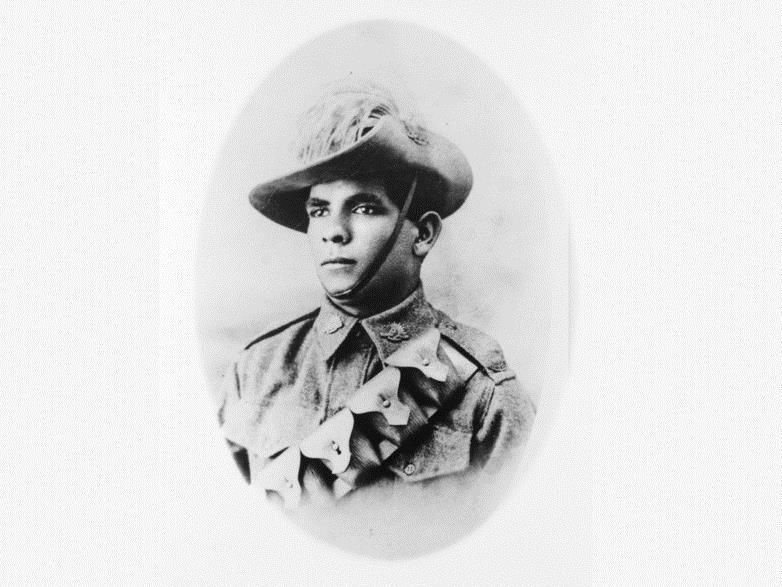Trooper Horace Thomas Dalton of the 11th Light Horse Regiment
I grew up as a white middle-class girl in a thoroughly white-bread environment, a rare dark-haired girl among braided blondes. There was even less dark skin at my school.
But as a Kiwi kid the glories of the Maori battalion were as much a part of my education as the heroism of the other Anzacs. I watched the ageing erect dark-skinned men, their hair no longer black, gathering among the other returned soldiers on Anzac Day at the cenotaph at the Auckland War Memorial Museum. The names on the Roll of Honour which lines the museum walls are not just Smiths and Joneses but also Henares and Rangis.
So, as an Australian of more than 25 years standing, it’s a shock to find that only now is my adopted country recognising its equivalent history. Indeed, if it were not for the creative insight of writer Tom Wright and director Wesley Enoch the story of the Aboriginal Anzacs would remain untold.
Black Diggers, which premieres at the Sydney Festival tomorrow, is an important attempt to tell the untold story of the Aboriginal Anzacs.
The power of a play like this is not just in what happens in the theatre but also in the way it places a stake in the ground of a much bigger conversation. The mere existence of Black Diggers will have far-reaching effects way beyond the audience who actually go to the theatre. Anyone leafing through a Sydney Festival program or catching an advertisement for the play on the side of a bus is instantly made aware of the unfamiliar juxtaposition of those two words ‘Black’ and ‘Digger’.
We have stereotypes about Blacks with which we are all too familiar: the kinds of stereotypes which mean an Aboriginal actor is usually cast as a prostitute, drug addict or criminal. But we also have stereotypes for Diggers, salt-of-the-earth men with little education but lots of guts, rugged Aussie blokes from the bush who waved off their sweethearts and donned khaki to look like so many clones of Mel Gibson in Gallipoli.
In fact there were gay Anzacs and city Anzacs, boys who put university courses on hold, young men who had never had a partner and some who never would and, of course, a small but important group of Indigenous Australians whose service is all the more poignant because they were not even citizens, so primitive was Australia in its treatment of Aboriginal people.
It matters that we acknowledge these different kinds of Australian heroes not for the men themselves – who if they did not die on the battlefield are certainly dead now – but because in telling our national history we create our national consciousness.
The contrast between the service Indigenous Australians gave their country and the way their country treated them is a national disgrace. Although they received equal pay and equal treatment while in the military, back in Australia they faced discrimination, lost land and even had their children stolen.
As University of Sydney researcher into the subject Dr David Williams puts it, ‘We have actively forgotten their service. The contrast between them being treated as equals when they’re in the military and being treated as second-class inferior people when they return from the war is quite striking.’
Some ex-serviceman received settlements of land to re-start their lives but occasionally this was Aboriginal land, even stolen from other ex-servicemen. Even worse was the treatment of families. Researching the play Enoch told the ABC he uncovered stories of Indigenous children being removed from their mothers while their fathers were at war.
For a New Zealander-by-birth and an Australian-by-choice the contrast between the two countries that made up the Anzacs is never stronger than in their treatment of the Indigenous peoples.
There are many historical reasons for Australia’s poor record. At settlement the Maori were one people, separated by warring tribes but culturally and linguistically cohesive, and able to put up a strong defence against British invasion resulting in the Treaty of Waitangi, which acknowledged Maori prior ownership of the land and struck a price for British settlement.
That’s a marked contrast with the declaration of Australia as Terra Nullius and the complete lack of awareness that the disparate and much more easily conquered Indigenous peoples of Australia constituted prior owners.
The history of settlement set the stage for a very different political engagement. While the New Zealand situation is far from perfect the early establishment of parliamentary ‘Maori seats’ ensured civic representation and a few landmark leaders were able to gain both education and power. The first Maori MPs were elected in 1868 and by 1914 Sir Apirana Ngata could argue powerfully that the formation of the Maori battalion was ‘the price of citizenship’.
By contrast Aborigines were not citizens for another 53 years and the first Aboriginal MP was not elected until Neville Bonner was elected in 1971.
Scale makes a difference too: 450,000 enlisted in WWI of which an estimated 1,000 were Aboriginal; 100,444 New Zealanders fought and the Maori battalion numbered 3,600, still a small number but a significantly greater proportion.
The Maori battalion became one of the most decorated units in World War I, the reason every New Zealand school child knows about it. It was a big part of making Maori culture acknowledged and celebrated. When we went to the War Memorial Museum as children we played in the Maori meeting house and saw the art and artefacts of the Indigenous people given pride of place.
It is only in recent years that Indigenous Australian art has gained similar primacy. The paintings of Richard Bell, choreography of Stephen Page and theatre of Enoch, among many others, are essential to building a new Australian identity.
Here’s to hoping Black Diggers is not only successful as a festival play but also finds its way into the curriculum and the national media as a sustained part of our Anzac commemorations. The power of theatre – and other art forms – to transform this conversation is enormous and deeply needed.





